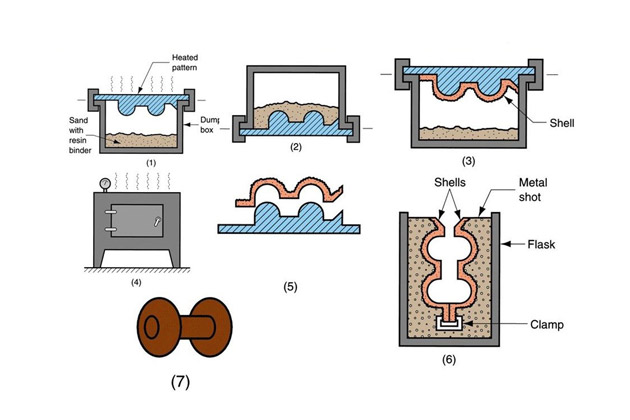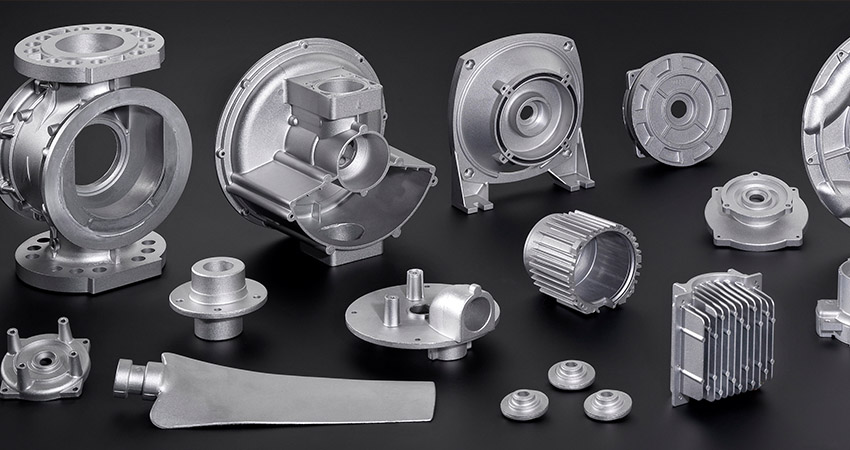The hidden benefits of Aluminum Casting
Every little thing You Required to Find Out About the Uses and Perks of Aluminum Castings
Aluminum castings play a crucial duty across various industries, offering unique residential or commercial properties that improve item performance. Their lightweight nature and stamina make them perfect for applications in automobile and aerospace markets. Furthermore, the adaptability of casting approaches enables for elaborate designs and tight resistances. As the demand for lasting options climbs, understanding the advantages and applications of aluminum castings ends up being increasingly crucial. What specific benefits do they offer over other materials?
Review of Aluminum Casting Processes
Aluminum casting procedures include a selection of strategies made use of to shape liquified aluminum right into desired forms. These techniques consist of sand casting, die spreading, and financial investment spreading, each offering distinct benefits relying on the application (Aluminum Casting). Sand spreading involves producing a mold and mildew from sand, permitting for detailed designs and big elements, while die casting uses high stress to inject liquified aluminum into steel mold and mildews, making sure accuracy and smooth coatings. Investment casting, additionally called lost-wax spreading, produces complex shapes with superb dimensional accuracy, making it appropriate for in-depth components
These procedures are defined by their ability to produce light-weight, durable components that display outstanding deterioration resistance. The adaptability of aluminum enables personalization in various markets, from automotive to aerospace. Additionally, the capability to reuse aluminum boosts the sustainability of these casting procedures, decreasing environmental impact while preserving material stability. Comprehending these techniques is essential for maximizing manufacturing effectiveness and accomplishing top notch aluminum castings.
Key Applications of Aluminum Castings
Aluminum castings play a necessary function throughout different sectors, specifically in automobile, aerospace, and consumer electronic devices. In the auto sector, they add to light-weight frameworks that improve fuel effectiveness. Similarly, aerospace parts profit from aluminum's strength-to-weight proportion, while consumer electronics take advantage of its adaptability for reliable production.
Automotive Industry Applications
As the automobile sector remains to develop, makers progressively count on aluminum castings for their light-weight yet resilient buildings. These castings play an essential duty in improving automobile performance, gas performance, and overall security. Secret applications include engine blocks, transmission real estates, and structural parts, which take advantage of aluminum's superb strength-to-weight ratio. Additionally, aluminum castings help with complex geometries, enabling cutting-edge designs that enhance aerodynamics and lower drag. The corrosion resistance of aluminum also adds to longevity, lowering upkeep expenses for both suppliers and customers. As electrical automobiles gain appeal, aluminum castings are essential for battery rooms and other components, additionally strengthening their importance in the future of automotive production.
Aerospace Element Production
In the aerospace sector, aluminum castings are integral to the manufacturing of light-weight, high-performance components. These castings are vital for producing parts such as engine housings, architectural structures, and landing equipment parts, where weight decrease is important for gas effectiveness and general efficiency. The outstanding strength-to-weight proportion of aluminum enables the growth of intricate geometries that enhance the rules of aerodynamics. Furthermore, aluminum's resistance to corrosion adds to the longevity and reliability of aerospace components, guaranteeing safety in trip operations. The spreading process additionally enables precise resistances, which is very important in meeting rigid aerospace market criteria. In general, aluminum castings play a pivotal duty beforehand aerospace innovation while sustaining the market's promote lasting practices.
Consumer Electronic Devices Production
Using aluminum castings in consumer electronic devices manufacturing has actually become progressively substantial because of their lightweight and resilient residential or commercial properties. Suppliers leverage these castings to create components for different gadgets, including smart devices, laptop computers, and gaming consoles. Aluminum's excellent thermal conductivity likewise aids in warm dissipation, improving device performance and long life. The versatility of aluminum permits for detailed layouts and intricate geometries, making it possible for smooth and contemporary appearances that appeal to consumers. Furthermore, aluminum castings can be conveniently reused, lining up with the growing need for lasting manufacturing methods. As innovation advancements, the role of aluminum castings in establishing ingenious and efficient customer electronic devices is expected to increase, making them a staple in the market.

Advantages of Making Use Of Aluminum Castings
While different products are offered for casting, aluminum stands out due to its one-of-a-kind combination of light-weight homes, toughness, and corrosion resistance. The low density of aluminum makes it an excellent choice for applications where weight decrease is important, such as in the automobile and aerospace sectors. Its exceptional strength-to-weight proportion enables producers to produce resilient parts without including extreme weight.
Additionally, aluminum castings can be produced with detailed styles and limited tolerances, making it possible for intricate geometries that are difficult to achieve with other products. The adaptability of aluminum enables for different casting techniques, consisting of sand, pass away, and financial investment casting, accommodating varied production needs. Moreover, aluminum's simplicity of machining and completing enhances its allure, facilitating the production of top quality surface area coatings. In general, the advantages of using aluminum castings add to enhanced performance and performance in various applications across various industries.
Corrosion Resistance in Aluminum Castings

All-natural Oxide Layer
A natural oxide layer kinds on the surface of aluminum castings, offering a vital barrier versus ecological variables that can lead to degeneration. This slim, safety film is a result of the aluminum's reaction with oxygen airborne, properly securing the underlying steel from wetness, chemicals, and pollutants. Because of this, aluminum castings display remarkable deterioration resistance, which boosts their durability and longevity in various applications. The oxide layer is not only useful for defense yet additionally adds to aesthetic high qualities, as it can develop a matte surface my latest blog post that many industries discover appealing. In addition, this natural process reduces the requirement for extra finishes, making aluminum castings an economical choice for suppliers looking for reliable, resilient materials.
Alloy Variations Influence
The make-up of aluminum alloys significantly influences their corrosion resistance residential or commercial properties in castings. Various alloy variations, such as 1xxx, 2xxx, and 6xxx collection, display distinct degrees of vulnerability to deterioration. For example, 1xxx alloys, largely composed of pure aluminum, offer exceptional rust resistance due to their high purity. On the other hand, 2xxx alloys, which have copper, may experience considerable rust when revealed to harsh environments. On the other hand, 6xxx alloys, integrating magnesium and silicon, strike a balance between strength and resistance. The visibility of alloying elements can boost or diminish safety oxide layers, eventually impacting durability and efficiency. Recognizing these variants is important for picking the ideal alloy for details applications where rust resistance is critical.
Style Flexibility and Customization
Although numerous products exist for casting applications, aluminum stands out due to its impressive layout flexibility and possibility for customization. This convenience allows designers and designers to create complex shapes and types that meet details practical demands. Aluminum Casting. The low density of aluminum enables lightweight styles, which is especially advantageous in markets such as automobile and aerospace, where weight decrease is vital
Aluminum castings can be customized to different requirements, consisting of wall thickness, surface area coating, and dimensional tolerances. This versatility not only enhances the aesthetic appeal however also improves the efficiency of the end product. Additionally, progressed strategies such as 3D printing and computer-aided design (CAD) further help with the personalization process, enabling fast prototyping and lowering preparations. Aluminum castings can successfully fulfill the varied demands of different markets while using producers the capability to innovate and respond swiftly to market needs.
Contrast With Other Casting Products
While various casting products each have their distinct advantages, aluminum regularly shows premium residential or commercial properties that make it a favored option in several applications. Compared to iron and steel, aluminum is substantially lighter, which minimizes the general weight of completed items, boosting fuel effectiveness in vehicle and aerospace industries. Aluminum supplies excellent deterioration resistance, calling for less upkeep over time compared to products like iron, which can corrosion.
When juxtaposed with plastics, aluminum's stamina and longevity exceed many artificial options, making it suitable for requiring atmospheres. On top of that, aluminum's thermal and electrical conductivity is incredibly more than the majority of other metals, making it optimal for applications needing efficient warmth dissipation or electrical parts.

Future Fads in Aluminum Casting Technology
Developments in aluminum casting modern technology are established to redefine its applications across different sectors. Developments in automation and robotics discover this are improving manufacturing processes, improving efficiency and accuracy. The integration of synthetic intelligence and artificial intelligence makes it possible for real-time tracking and predictive upkeep, lowering downtime and enhancing quality control.
Furthermore, the growth of advanced alloys is increasing the performance capacities of aluminum castings, making them suitable for more requiring applications, particularly in vehicle and aerospace industries. Sustainable techniques are likewise acquiring traction, with enhanced emphasis on reusing aluminum and reducing carbon impacts during production.
Additive production methods, such as 3D printing, are being discovered to create complicated geometries that traditional approaches can not achieve, enabling greater design flexibility. These fads suggest a future where aluminum spreading will certainly not just satisfy however exceed market assumptions, driving advancement and sustainability in manufacturing.
Often Asked Inquiries
Exactly How Are Aluminum Castings Recycled After Use?
Aluminum castings are generally website here collected, cleaned, and refined in reusing centers. The material is melted down, fine-tuned, and after that reformed into new items, thereby conserving sources and lowering ecological influence while maintaining aluminum's desirable residential properties.
What Are the Typical Prices Connected With Aluminum Castings?
The common expenses related to aluminum castings vary based on elements such as intricacy, quantity, and material specifications. Generally, rates range from a couple of bucks per extra pound to substantially greater amounts for complex styles and big amounts.
Just How Do Aluminum Castings Contrast in Weight to Steel Castings?
Aluminum castings evaluate considerably much less than steel castings, usually around one-third the weight (Aluminum Casting). This reduced mass permits simpler handling, transport, and application in different industries, adding to improved effectiveness in layout and manufacturing processes
What Industries Primarily Rely Upon Aluminum Castings?
Various markets significantly count on aluminum castings, including vehicle, aerospace, electronic devices, and consumer products. Their light-weight nature, deterioration resistance, and adaptability make them necessary for making elements in these industries, improving efficiency and performance.
Exist Any Kind Of Health Threats Related To Aluminum Casting Processes?
Wellness risks related to aluminum casting processes consist of direct exposure to fumes, dust, and chemicals, which can cause respiratory concerns and skin irritability. Proper precaution and devices are vital to reduce these possible risks in the workplace.